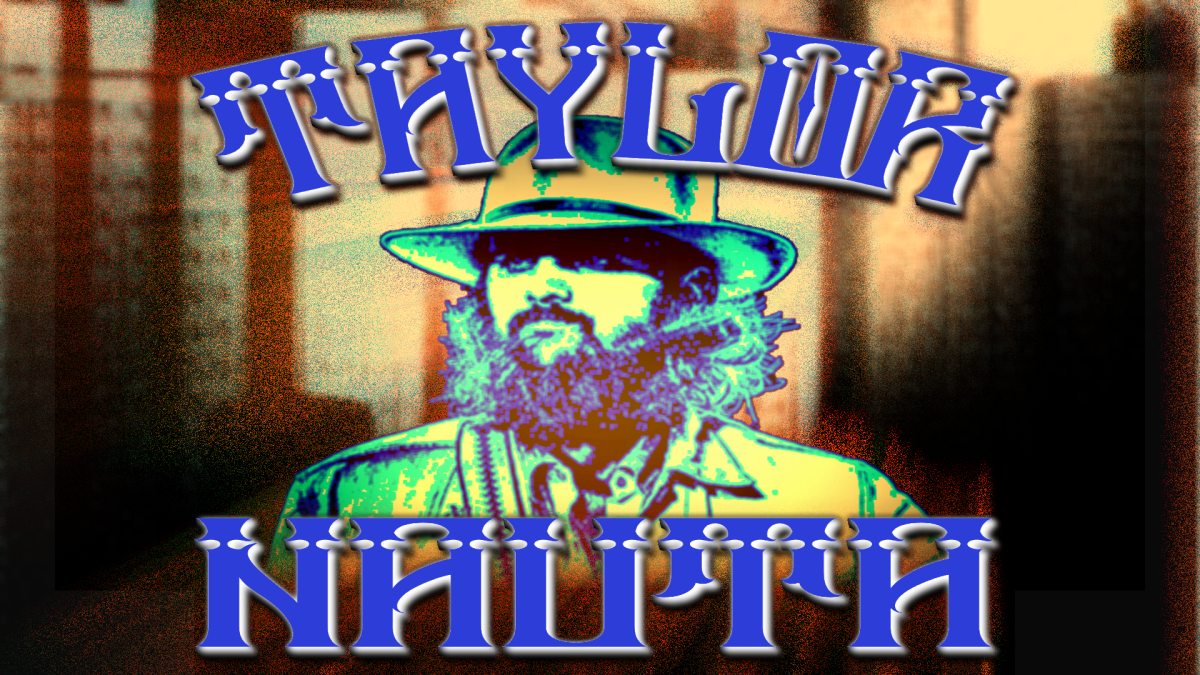As children, we’ve all experienced one family member that seemed to have more of an impact on us that the rest. Their words, habits, or tendencies are something we still carry with us to this day. For Taylor Nauta, that person was his grandfather. With his dad at work most of the time and his mother having fallen ill, the two spent much time together. Though their generational gap spanned some fifty-eight years, they connected through music. Taylor’s grandfather was a country music fan and shared this passion with Taylor. The needle would drop onto a record, heavy knobs were turned on a vintage Sony stack unit, and the eyes of a child grew wide. Twangy melodies and rustic notions emanated from wood cabinet speakers, filling Taylor with the tenets of those like Merle Haggart, Johnny Cash, Roger Miller, and Waylon Jennings. These were voices that predated Taylor’s very existence; each with a style all their own. In speaking with Taylor about these moments, I could tell they posed more than a simple child-like fascination. Whether either of them realized it or not, his grandfather instilled in Taylor what became a deep-seeded respect for history and a value in sentiment. Those indoctrinated with this are the ones who dissuade future generations from diluting keystones like societal mores and cultural traditions.
Taylor first picked up a guitar at the age of seven under the direction of his grandfather, who also played. Those vinyl sessions began to take new meaning, as Taylor tried to decipher audio that passed through aged tweed. By fourteen, Taylor was playing constantly and even writing his own songs. But he had gotten all he could out of the guitar he was given. The strings sat far off the neck, making it a challenge to both play and keep in tune. One night, he played a song for his father and grandfather that really impressed them both. It was a Chet Adkins styled piece where he plucked an alternating bassline with his thumb while simultaneously playing the melody with his fingers. As he sang along in a Jimmy Rodgers yodeling manner, both realized that he had become something greater than expected. Soon, they would pitch in and buy him his first really nice guitar, a Takamine F-349. That solid wood top and high-quality tone wood so inspired him to keep learning and growing as a musician. It comes as no surprise that by the age of fifteen, you could find him at school playing tunes like Cannonball Rag, a Merle Travis record from 1952. And you could find the girls passing him by to listen to the emo musician down the hall. After noticing this, Taylor chose country radio stations of the time over his grandfather’s records when searching for inspiration. Moving forward, he would come to realize that material born out of the early 90’s was far superior to the pop style country that would come from the early 2000’s. He stated, “The guitar solos and cool intros were common in 90’s country. And now they’ve just about gutted that stuff out. If there’s a guitar solo at all in today’s country, it’s short; real short, like a lick or two and you’re out of it.” Though he explored his sonic surroundings to sample what was out there, he remained true to his roots when it came to musicianship. He considers himself lucky to have experienced both the solid foundation of his predecessors and the remarkable creativity that was characteristic of early 90’s country music. He shudders to think what he might have become if he grew up during the era of pop infusion.
They say hindsight is 20/20, but at this point Taylor was just a kid trying to find his way. We all can recall moments in our lives when perhaps we didn’t know which way to go. He had an idea of where he wanted to end up. He wanted to sing and play guitar like the stars he’d seen as a child on The Grand Old Opry. Likewise, he knew the caliber of musician he wanted to be but may not have known what things landed him below that mark. At one point, he had the benefit of a few months with an instructor. This taught him things like basic theory and the concepts of scales and modes. Although short lived, this helped him immensely. As he was able to recognize when guitarists articulated pentatonic, major scale and arpeggio methods in songs. At seventeen, he was invited to the studio of James Marsden, a man whom, among other things, held several credits for Disney song production. Taylor was able to perform a few songs for James and hear his thoughts. James expressed reassurances, but pointed out that there was room for improvement. He told Taylor to listen to songs by Rascal Flats or Clint Black and ask himself what gives those artists their signature style. Then try writing songs in the vein of those artists; songs that Taylor thought would be performed by those artists. He also suggested Taylor purchase a metronome or drum machine because he found Taylor to be playing along more with his voice than the rhythm signature. Taylor went out and bought a Digitech FX pedal that came with drum loops. Following James’ advice tidied up his right hand quite a bit, cementing this gift in his mind.
The following year in 2006, he moved from his hometown of Baton Rouge, Louisiana to Nashville to pursue his dreams. He arrived with his acoustic Takamine F-349, a Telecaster, and a duffle bag. He would be living in Franklin, a suburb just south of Nashville, in an apartment with Vickie, a church acquaintance of his aunt. He had thirty days to find a job and start paying rent. One day, he was at the mall and saw a sign with a job opportunity for a karate instructor. He had taken years of Tang Soo Do as a child, but the sign was for Tae Kwon Do. Still, he sold himself stating that both were Korean martial art styles and was given a job as an instructor at the Yong In Martial Arts Academy. With his financial piece being solved, he began to put together more of the puzzle. Taylor frequented the local clubs and bars to get a taste for what was out there. He spent countless nights waiting in line to perform at writer’s rounds. Very quickly, he realized how small of a fish he had become in such a big pool of talent. But his thirst for success could not be depleted. When not roaming the entertainment district, he would practice in a loft above the gym at Vickie’s apartment complex. One of those evenings, a man poked his head up to talk to Taylor. He complimented Taylor on his music and, handing him a business card, asked if he would come play some songs for him at his place. The stranger turned out to be Walt Aldridge, a member of The Nashville Songwriters Hall of Fame and The Alabama Music Hall of Fame. His repertoire included hits for Travis Tritt, Conway Twitty, Tim McGraw, Reba McEntire, Ronnie Milsap, and Barbara Mandrel (And I’m only scratching the surface here).
The night Taylor went to Walt’s place, Walt handed an old Gibson to him and asked what he thought of it. Though it looked a bit old and worn, Walt explained that the guitar used to belong to Johnny Cash. Taylor was frozen, taking notice of how the buttons on his shirt were touching this holy grail of instruments. After playing a few of his tunes, Walt imparted some insight to Taylor. He told Taylor that he thought his songs were good but admitted he hadn’t heard a hit. He felt Taylor needed to trim the fat. “Genius is when big implications are expressed with fewer words”, he said. Walt critiqued each one of Tayor’s songs individually. He would send Taylor off with homework assignments, directing him to write songs meant for certain artists and critique those as well. With his work cut out for him musically, Taylor was able to inch forward occupationally when Vickie tapped on a church acquaintance to land him a job at Gibson Guitars. His pay jumped from $8 to $12 an hour, which was decent money back in 2006. While there, he befriended an ex-marine by the name of Brian James. Brian was a bit older than Taylor, had nice gear, and had an overall cool image. He played in a rock band in the Marine Corps and had experience playing in a touring band before coming to Gibson. Taylor looked up to him. One day Taylor asked him how he could learn to play like Brian. The first thing Brian wanted to know was who Taylor was listening to. When Taylor started naming named like Merle Haggard and Chris Ledoux, Brian began to shake his head and replied, “No, man, you’re never going to become a great player listening to that stuff. Here’s what you need to listen to.” Brian turned Taylor on to musicians like Joe Bonamassa, Kenny Wayne Shephard, Stevie Ray Vaughn, Albert King, and Buddy Guy. The world of blues-rock was an influence Taylor hadn’t considered before. He crawled through the works of these artists and, by the time he watched Eric Clapton’s Crossroads DVD, he was hooked. He even went out and bought a Stratocaster because he loved the blues sound so much.
Technically speaking, the blues were more attainable to Taylor. The licks weren’t as involved as what he had been playing. Taking in the big picture, I’d say it was just what he needed to push himself further at that time. If you recall, James Marsden recommended he pay more attention to his timing, urging him to get a metronome or a drum machine. And with a groove music like blues, timing is everything. With some hard work, the time he spent with Brian would enable him to improve his repertoire. And with all of the work he put in at Gibson, he was able to move out of Vickie’s apartment and get a place of his own. Things were looking up. But so far, the only exposure he had to performing in front of crowds was at writer’s rounds with his acoustic. A local musician by the name of Dustin Wilkes was performing one night at Tootsie’s Organ Lounge, a place Taylor frequented. The guitarist, Brad Wolf, was someone he followed and respected. Taylor would often hit the guy with a barrage of questions about his gear and his technique. So, it was easy for Brad to surmise that Taylor was an aspiring musician. One night Brad needed a cigarette break. He looked at Taylor, pointed to his guitar, then pointed to him with a quizzical look on his face. Taylor eagerly responded. This would mark the first time a teenaged Taylor was in front of a crowd, with a band, and with an electric guitar. The band started running through songs to see which ones he knew and could play. They arrived at something he was ready to play, “Right Where I need to Be”, by Gary Allen. They followed with “Folsom Prison Blues”, by Johnny Cash and “Can’t You See”, by The Marshall Tucker Band. He was able to sing that night as well. And to top it all off, he got the nod from Dustin Wilkes. Dustin performed on the famed tv show, The Nashville Star. So, his approval meant a lot to Taylor. It also meant scoring his own gig at Tootsie’s, which would, in turn, lead to others.
Taylor was able to form a band, playing bars, parties, and casinos all over town. He would also eventually meet a girl and fall in love. She happened to be the grand daughter of Merle Kilgore, who co-wrote Burning Ring of Fire, managed Hank Williams Jr., and was the president of the Country Music Awards. The two married and had children. But as Taylor put it, “she was too generous with her affections” and the two would divorce. He reached a point where he needed to put some miles between himself and how flawed his personal circumstances had become. It was time for him to leave Nashville. His musical identity had taken a long time to figure out. Comparing and contrasting while in the eyes of a crowd accelerated this process for him while there. So, his time in Nashville was invaluable. Brian James, his co-worker at Gibson, was what he considers to be one of the pivotal moments in his life. I’d say his meetings with James Marsden and Walt Aldridge had meaningful impacts as well. The two echoed the importance of timing and overall song arrangement. The fact that Walt chose to invest time in him was perhaps something he hadn’t considered during that moment. The man’s background towered over Taylor and nervousness was more prevalent. But during these experiences, a young kid was learning and growing, and shoring up his ego bit by bit. Today, with three singles, two albums, and countless hours performing for crowds under his belt, Taylor still remains astute. His diversity and experiences have enabled him to play throughout the gulf south, Tennessee, Kentucky, the Midwest, up and down the west coast, and Canada. And he continues to stand as a creative force in our music community. In March of 2022, he released his debut album, “Walk of Shame Hall of Fame”. They were followed that same year by two singles, “Shittin’ on Company Time” and “Shrimp Boots”. Then, in January of 2023, he released another single titled “Fuck Everything”. And he followed that with a second album in December titled, “Weather the Storm”. A flood in 2016 spelled the end for that first real guitar his father and grandfather chipped in to buy him. But his wife had it painted, and it now hangs on his wall. This, along with the words and melodies of Merle Haggard, Johnny Cash, Hank Thompson, and other names of old are some of the things that Taylor carries with him to this day. Instilled within him is a deep appreciation for the family and the music from whence he came. And you can hear it in his music today. The solos still ring true, the origins are carried forth, and his spin on those traditions are what he brings to the table. He is the genuine article.
Author: David Trahan



















